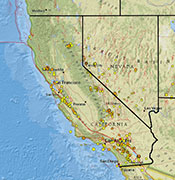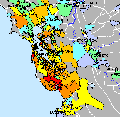

Advances in technology have made it possible to integrate separate earthquake monitoring networks into a single seismic system as well as to unify earthquake monitoring instrumentation. In California, this effort began in the south with the TriNet Project. There, Caltech, the California Geological Survey (CGS), and the USGS created a unified seismic system for Southern Califor- nia.
With major funding provided by the Federal Emergency Management Agency (FEMA), the California Governor's Emergency Management Agency (CalEMA), and the USGS, monitoring infrastructure was upgraded and expanded, combining resources in a federal, state and university partnership. In 2000, the integration effort expanded to the entire state with the formation of the California Integrated Seismic Network (CISN, see 2000-2001 Annual Report). To this end, UC Berkeley and the USGS Menlo Park and Pasadena offices joined forces with Caltech and the CGS.
The CISN is now in the twelfth year of collaboration and its eleventh year of funding from CalEMA.
The organizational goals, products, management, and responsibilities of the CISN member organizations are described in the founding memorandum of understanding and in the strategic and implementation plans. To facilitate activities among institutions, the CISN has three management centers:
The Northern and Southern California Earthquake Management Centers operate as twin statewide earthquake processing centers, serving information on current earthquake activities, while the Engineering Strong Motion Data Center is responsible for producing engineering data products and distributing them to the engineering community.
The Steering Committee, made up of two representatives from each core institution and a representative from CalEMA, oversees CISN projects. The position of chair rotates among the institutions; Ken Hudnut from the USGS Pasadena took over as chair of the Steering Committee in December 2010 from Barbara Romanowicz. Rob Graves will complete the USGS Pasadena term as Steering Committee chair.
An external Advisory Committee represents the interests of structural engineers, seismologists, emergency managers, industry, government, and utilities, and provides review and oversight. The Advisory Committee is chaired by Loren Turner of Caltrans. It last met in December 2011. Agendas from the meetings and the resulting reports may be accessed through the CISN website The Steering Committee has commissioned other committees, including a Program Management Group to ad- dress planning and coordination and a Standards Committee to resolve technical design and implementation issues.
In addition to the core members, other organizations contribute data that enhance the capabilities of the CISN. Contributing members include: University of California, Santa Barbara; University of California, San Diego; University of Nevada, Reno; University of Washington; California Department of Water Resources; Lawrence Livermore National Lab; and Pacific Gas and Electric Company.
The USGS Advanced National Seismic System (ANSS) has developed along a regionalized model. Eight regions have been organized, with the CISN representing California. David Oppenheimer of the USGS represents the CISN on the ANSS National Implementation Committee (NIC).
The CISN has recently benefited from the American Recovery and Reinvestment Act (ARRA). The ANSS received funds from the ARRA to improve seismic monitoring throughout the nation and the world. In California, these funds were directed toward replacing old data loggers in both Northern and Southern California, as well as improving installations at individual stations and adding strong motion sites in the form of NetQuakes sensors. The BSL's ARRA-funded activities were mostly completed in previous years, and are described in the corresponding annual reports. The most recently completed ARRA-funded, and other, upgrades are described in are described in Operational Sections 1, 4 and 3. As the ANSS moves forward, committees and working groups are established to address issues of interest. BSL faculty and staff have been involved in several working groups of the Technical Integration Committee, includ ing Doug Dreger, Peggy Hellweg, Pete Lombard, Doug Neuhauser, Bob Uhrhammer, and Stephane Zuzlewski.
CalEMA has long had an interest in coordinated earthquake monitoring. The historical separation between Northern and Southern California and between strong-motion and weak-motion networks resulted in a complicated situation for earthquake response. Thus, CalEMA has been an advocate of increased coordination and collaboration in California earthquake monitoring and encouraged the development of the CISN.
In FY 01-02, Governor Gray Davis requested support for the CISN, to be administered through CalEMA. Funding for the California Geological Survey, Caltech and UC Berkeley was made available in spring 2002, officially launching the statewide coordination efforts. Following the first year of funding, CalEMA support led to the establishment of 3-year contracts to UC Berkeley, Caltech, and the California Geological Survey for CISN activities. We have just completed the first year of the fourth three-year contract (2011-2014). Unfortunately, state funding to the CISN has been decreasing as the state's budget problems have increased, putting pressure on our earthquake monitoring and reporting activities.
03/17/2014: Mw 4.4 Encino, CA
03/10/2014: Mw 6.8 offshore Mendocino, CA Seismo Blog post
08/26/2012: Update on the August 2012 Earthquake Swarm in the Brawley Seismic Zone
03/05/2012: Mw 4.0, El Cerrito, CA
10/21/2010: The Great California ShakeOut
07/7/2010: Mw 5.4 Collins Valley Earthquake
06/15/2010: Mw 5.7 Aftershock to the Mw 7.2 El Mayor-Ccapah Earthquake
04/05/2010: Mw 7.2 Sierra El Mayor Earthquake (Northern Baja California)
For more information on current aftershock activity, consult the Southern California Seismic Network web page.
03/16/2010: ML 4.4 near Pico Rivera, Los Angeles Basin
01/10/2010: Mw 6.5 Gorda Plate Earthquake
12/30/2009: Mw 5.8 Baja California Earthquake
10/06/2009: Update on Olanchan Earthquake Swarm, Olancha, CA
03/24/2009: Mw 4.8, part of Bombay Beach, CA swarm

|
Recent Earthquakes: maps and lists for the most recent earthquakes. |

|
Internet Quick Reports: Earthquake engineering reports from the Engineering Data Center |

|
ShakeMaps: maps showing the distribution of ground shaking. |

|
Earthquake Special Reports Earthquake seismology reports from CISN Management Centers |

|
Did you feel it?: Report your earthquake observations |

|
Earthquake Notification by email Sign up for earthquake notification messages |